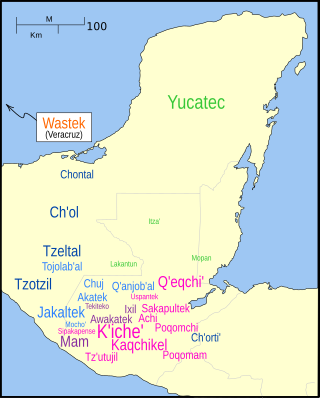Mbula is an Austronesian language spoken by around 2,500 people on Umboi Island and Sakar Island in the Morobe Province of Papua New Guinea. Its basic word order is subject–verb–object; it has a nominative–accusative case-marking strategy.

Tzeltal or Tseltal is a Mayan language spoken in the Mexican state of Chiapas, mostly in the municipalities of Ocosingo, Altamirano, Huixtán, Tenejapa, Yajalón, Chanal, Sitalá, Amatenango del Valle, Socoltenango, Las Rosas, Chilón, San Juan Cancuc, San Cristóbal de las Casas and Oxchuc. Tzeltal is one of many Mayan languages spoken near this eastern region of Chiapas, including Tzotzil, Chʼol, and Tojolabʼal, among others. There is also a small Tzeltal diaspora in other parts of Mexico and the United States, primarily as a result of unfavorable economic conditions in Chiapas.
In theoretical linguistics, a distinction is made between endocentric and exocentric constructions. A grammatical construction is said to be endocentric if it fulfils the same linguistic function as one of its parts, and exocentric if it does not. The distinction reaches back at least to Bloomfield's work of the 1930s, who based it on terms by Pāṇini and Patañjali in Sanskrit grammar. Such a distinction is possible only in phrase structure grammars, since in dependency grammars all constructions are necessarily endocentric.

The Tarahumara language is a Mexican Indigenous language of the Uto-Aztecan language family spoken by around 70,000 Tarahumara (Rarámuri/Ralámuli) people in the state of Chihuahua, according to a 2002 census conducted by the government of Mexico.
Araki is a nearly extinct language spoken in the small island of Araki, south of Espiritu Santo Island in Vanuatu. Araki is gradually being replaced by Tangoa, a language from a neighbouring island.
The Wuvulu-Aua language is a language spoken on the Wuvulu and Aua Islands, and by speakers across the Manus Province of Papua New Guinea. Although the Wuvulu-Aua language has a similar grammatical structure, word order, and tense to other Oceanic languages, it has an unusually complex morphology.
Bororo (Borôro), also known as Boe, is the sole surviving language of a small family believed to be part of the Macro-Gê languages. It is spoken by the Bororo, hunters and gatherers in the central Mato Grosso region of Brazil.

The Nukak language is a language of uncertain classification, perhaps part of the macrofamily Puinave-Maku. It is very closely related to Kakwa.
Tlahuitoltepec Mixe, called South Highland Mixe in Wichmann (1995), is a Mixe language spoken in Mexico.
Kiwai is a Papuan language, or languages, of southern Papua New Guinea. Dialects number 1,300 Kope, 700 Gibaio, 1,700 Urama, 700 Arigibi, 3,800 Coast, 1,000 Daru, 4,500 Island, 400 Doumori. Wurm and Hattori (1981) classify Arigibi as a separate language.

Iatmul is the language of the Iatmul people, spoken around the Sepik River in the East Sepik Province, northern Papua New Guinea. The Iatmul, however, do not refer to their language by the term Iatmul, but call it gepmakudi.

Duna is a Papuan language of Papua New Guinea. It may belong to the Trans New Guinea language family and is often further classified as a Duna-Pogaya language, for Bogaya appears to be Duna's closest relative, as evidenced by the similar development of the personal pronouns. Estimates for number of speakers range from 11,000 (1991) to 25,000 (2002).
The Kwaio language, or Koio, is spoken in the centre of Malaita Island in the Solomon Islands. It is spoken by about 13,000 people.
Aramba (Arammba), also known as Serki or Serkisetavi, is a Papuan language of Papua New Guinea. It is spoken to the south of Western Province in the Trans Fly region. Aramba belongs to the Tonda Sub-Family, which is next to the Nambu Sub-Family region and the Suki language. Alternative names for the language include Upper Morehead, Rouku, Kamindjo and Tjokwasi.
Bukiyip (Bukiyúp), or Mountain Arapesh, is an Arapesh language (Torricelli) spoken by around 16,000 people between Yangoru and Maprik in the East Sepik Province of Papua New Guinea. Bukiyip follows the SVO typology. The Arapesh languages are known for their complex noun-phrase agreement system.
Irarutu, Irahutu, or Kasira, is an Austronesian language of most of the interior of the Bomberai Peninsula of north-western New Guinea in Teluk Bintuni Regency. The name Irarutu comes from the language itself, where ira conjoins with ru to create 'their voice'. When put together with tu, which on its own means 'true', the meaning of the name becomes 'Their true voice' or 'The people's true language'.
Safeyoka, or Ampale, is an Angan language of Papua New Guinea. Other names of this language include Ambari, Ampeeli, Ampeeli-Wojokeso, and Ampele. According to a 1980 census, there were around 2,390 native speakers. Commonly known as Ampale, the dialect is called Wojokeso. Speakers of Ampale range from the Waffa River to the Banir River, which is located in the northern part of Papua New Guinea. The Wojokeso dialect is spoken by people who live in five villages where multiple districts, the Kaiapit, Mumeng and Menyama come together in the Morobe Province.
Grass Koiari (Koiali) is a Papuan language of Papua New Guinea spoken in the inland Port Moresby area. It is not very close to the other language which shares its name, Mountain Koiali. It is considered a threatened language.
Lala, Nara, or Pokau is an Austronesian language of the central southern coast of the Papuan Peninsula in Papua New Guinea. This language is spoken in the villages of Oloi, Diumana, Ala'ala, Tubu, Kaiau and Vanuamae. A count in 2017 showed there to be about 3000 speakers with a current language status of developing, meaning that the language is in vigorous use, with literature in a standardized form being used by some.
This article describes the grammar of the Old Irish language. The grammar of the language has been described with exhaustive detail by various authors, including Thurneysen, Binchy and Bergin, McCone, O'Connell, Stifter, among many others.




